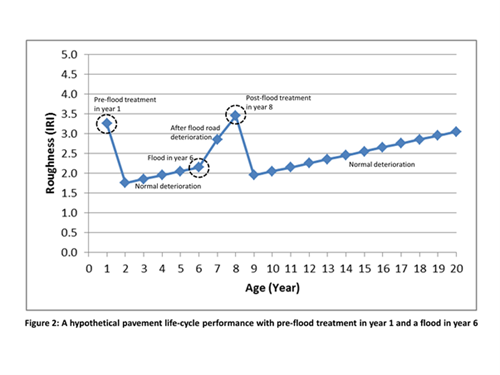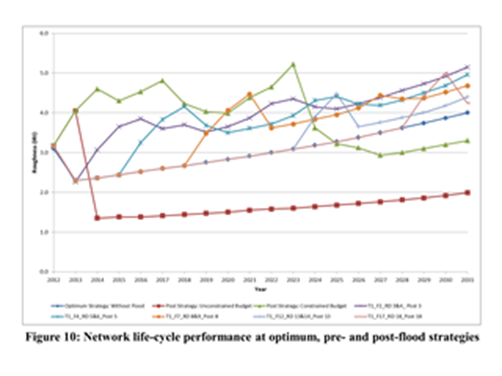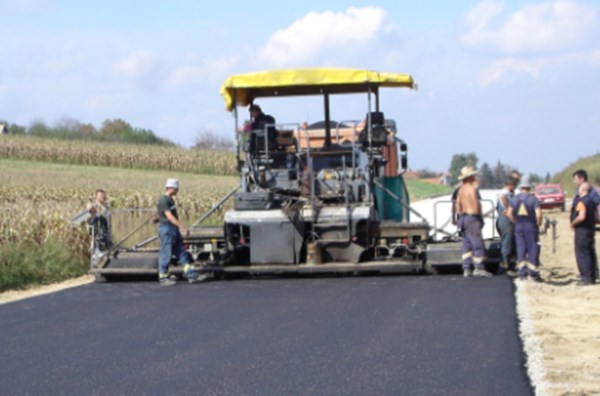Build and manage better road networks
- Home
- HDM-4 Version 2
- HDM-4 In Use
- Australia
- Proactive approach in managing roads before a flood comes
Proactive approach in managing roads before a flood comes
Misbah Khan, CPEng.1Mahmoud Mesbah, Ph.D.2Luis Ferreira, Ph.D.3 and David Williams, Ph.D.4
1Ph.D. Candidate, School of Civil Engineering, Univ. of Queensland, Brisbane, QLD 4072, Australia; Senior Asset Systems Engineer, Central Coast Council, 2 Hely St., Wyong, NSW 2259, Australia (corresponding author). E-mail: misbah_70@yahoo.com
2Lecturer, School of Civil Engineering, Univ. of Queensland, Brisbane, QLD 4072, Australia. E-mail: mahmoud.mesbah@uq.edu.au
3Professor, School of Civil Engineering, Univ. of Queensland, Brisbane, QLD 4072, Australia. E-mail: l.ferreira@uq.edu.au
4Professor, School of Civil Engineering, Univ. of Queensland, Brisbane, QLD 4072, Australia. E-mail: d.williams@uq.edu.au
(This description is based on the original paper: http://ascelibrary.org/doi/abs/10.1061/(ASCE)TE.1943-5436.0000901)
Summary:
No road authority has considered flooding in pavements’ life cycle analysis. Therefore, the authors have developed novel roughness and rutting based Road Deterioration (RD) models at project and network levels. These models provide pavement deterioration for a short period up to 3 to 4 years after a flood, which were validated with actual data. It is worth noting that there is not any road maintenance strategy available that address flooding in life cycle.
In view of that, as a proactive approach, the authors have developed a preflood road maintenance strategy. It suggests upgrading pavement strength now (Year 1) with a thin overlay, and then evaluating pavement lifecycle performance if a flood comes in different years. An after-flood treatment strategy would also be a part of the preflood strategy package. This proactive package is compared to a reactive package of just post-flood treatments. The analysis has used Highway Development and Management (HDM-4) model for deterioration prediction with or without a flood event and compared the proactive approach with the reactive one.
The study has considered normal deterioration after a treatment given in Year 1 and uses the new roughness and rutting based RD models to predict after-flood deterioration before providing post-flood treatments. The results show pavement performance, necessary treatments at Year 1 and any year, required budget, and economic results. The analysis uses representative road groups of the Queensland major road network as a case study, and the total pre-flood strategy cost is found at $37 to 38 billion in 20 years. A thin overlay is adequate for after-flood rehabilitation. This pre-flood strategy is economically beneficial and can maintain the network better.
Key Features:
- Proactive approach in managing roads with flooding in life-cycle.
- Optimum strategy’ treatments are given in Year 1, and normal deterioration are predicted using HDM-4 model.
- New and novel roughness and rutting based RD models with flooding are used after a flood to predict pavement deterioration for 2 to 3 years while post-flood treatments are expected to start next year after the flood.
- The HDM-4’s optimisation algorithm has been used to get the optimum after flood strategy for the whole network.
- Normal deterioration using HDM-4 are considered for the remaining period.
- The treatments in Year 1 and after a flood provided an overall pre-flood strategy, which is economically beneficial and ensures better pavement performances.
- Although one flood has been used in life cycle, this approach is valid for two or more floods

FIGURE: A hypothetical pavement life-cycle performance with pre-flood treatment in year 1 and a flood in year 6

FIGURE: Life-cycle performance for all the flexible and composite road groups at treatments in year 1 (2012) and a flood in year 4 (2015)

FIGURE: Network life-cycle performances at optimum, pre- and post-flood strategies
Acknowledgement: The authors like to thank to the Journal of Transportation Engineering, ASCE for publishing the original paper, which can be seen in http://ascelibrary.org/doi/abs/10.1061/(ASCE)TE.1943-5436.0000901. All the figures are extracted from the original paper.
-
Find out about the technical support service offered by HDMGlobal to help users use HDM-4 effectively.
-
For existing HDM-4 users, view the latest software release and the changes made before registering to receive the updates.
-
Find out about HDM-4 training courses offered by HDMGlobal and their partner organisations and other related events.








